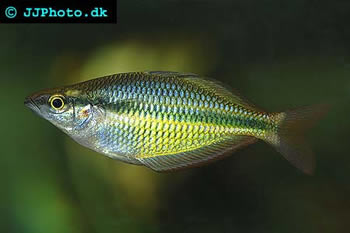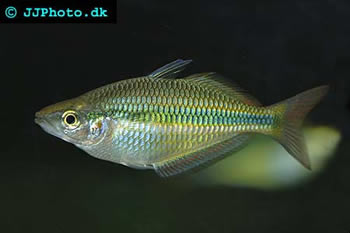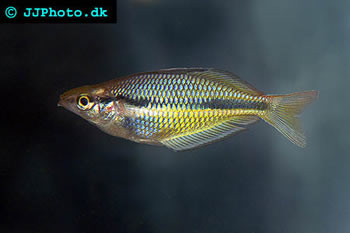Banded Rainbowfish - Melanotaenia trifasciata
The Banded Rainbowfish was scientifically described by Rendahl in 1922. It was however collected much earlier. In 1895, Knut Dahl, a zoologist from Norway, collected the species from Mary River. Its scientific name is Melanotaenia trifasciata.
Description
The banded Rainbowfish can reach a length of 13 cm (5 inches). If you wish to keep Banded Rainbowfish, there are many different colour variations to choose among from the wild. The upper part of the body can for instance be red, green, blue, purple or yellow. It is common for the dorsal, anal and caudal fins to be red or yellow. Most specimens have a distinct blackish or blue mid-lateral stripe. In most populations, the older males will have a deep body and a hump on the forehead.
Geographical distribution, habitat and conservation
The Banded Rainbowfish lives in the northernmost parts of the Australian continent. Its natural range is very limited and this species can only be found in the Northern Territory and the Cape York Peninsula. In the Northern Territory, the limits of the range consist of Melville Island, Mary River, Arnhem Land and Groote Eylandt. On the Cape York Peninsula, you can find Banded Rainbowfish north of Archer River, and there is also an isolated population living in the McIvor River.
|
The Banded Rainbowfish is often found in small creeks and streams with clear water. The bottom will normally consist of rocks or gravel, but can become littered with leaf during the dry season. The dry season can also force the Banded Rainbowfish to live in stagnant puddles with no current at all.
Banded Rainbowfish inhabits a lot of different habitats, from dry and open savannah to moist and densely grown semi-rainforest. When the Banded Rainbowfish lives in waterways on the savannah, it is often shadowed from the sun by Eucalypts and similar trees that grow along the banks of the streams and rivers. The pH-value varies from 5.2 to 7.0 in within the geographical range of this species.
The Banded Rainbowfish has not been evaluated for the IUCN Red List of Threatened Species. It is still common in both the Northern Territory and the Cape York Peninsula.
Keeping Banded Rainbowfish in aquariums
The Banded Rainbowfish is a popular aquarium species and it is not very difficult to care for. It is kept both in species aquariums and in community aquariums with other peaceful species of similar size that appreciated the same environment and water conditions. It is a very popular aquarium fish in Australia, and it has also managed to catch on in other parts of the world.
Even a small 50 litre (14 gallons) aquarium can comfortably house one male and two females. The Banded Rainbowfish is known to congregate around sunken trees in the wild, and will therefore appreciate hiding spots created by driftwood in the aquarium.
The Banded Rainbowfish is used to acidic (down to pH 5.2) or at least neutral conditions from the wild, but it can adapt to slightly alkaline conditions as well. Alkaline and neutral conditions can however make the fish look duller than normal. Keep the water temperature in the 23-27 degrees C (73-80 degrees F) range.
The Banded Rainbowfish needs a varied and nutritious diet to stay healthy. You can use prepared food as a base and supplement with fresh vegetables and occasional servings of live meaty food, e.g. insect larvae and small crustaceans.
Breeding Banded Rainbowfish
The Banded Rainbowfish is a prolific spawner that readily breeds in the aquarium. Sexing can be a bit tricky, but the first dorsal fin will normally will longer on the male. It is frequently so long that it overlaps the beginning of the second dorsal fin. Always keep at least two females for each male.
Acidic water is recommended, but it is not impossible to breed Banded Rainbowfish in alkaline conditions. Provide your fish to optimal water conditions and a nutritious diet that contains live food. Include a suitable spawning medium in the aquarium, e.g. java moss or spawning mops. Once you have managed to get your fish into breeding condition, the females can release over 50 eggs each per day.
The safest course of action is to move the spawning medium with the eggs to a separate container to avoid predation. Hatching will normally take place within a week if the keep the water temperature in the upper part of the recommended range. You can feed the fry infusoria and powdered flake food until they are big enough to eat newly hatched brine shrimp.
Didn't find the info you were looking for? Register for free and ask your question in our Aquarium forum !
Our knowledgeable staff usually responds to any question within 24 hours
Other Australian Rainbowfishes
Cairns Rainbowfish
Threadfin Rainbowfish
Lake Eacham Rainbowfish
Exquisite Rainbowfish
Murray River Rainbowfish
Slender Rainbowfish
MacCulloch’s Rainbowfish
Black-banded Rainbowfish
Pygmy Rainbowfish
Western Rainbowfish
Chequered Rainbowfish
Eastern Rainbowfish
Desert Rainbowfish
Ornate Rainbowfish




